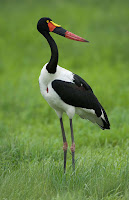 |
| Saddle-billed stork (female) |
The sexes of the saddle-billed stork can easily be told
apart, females have yellow irises while males have black irises and drooping
yellow wattles.
Sadly these magnificent storks are endangered in South
Africa and it is still not known exactly why their numbers are dwindling.
Habitat
They live throughout parts of sub-Saharan African from
Sudan though Ethiopia to South Africa including several Western African
countries. In the rainbow nation of South Africa, Saddle-billed storks make
home in the north-eastern parts of the country along the waters of the Kruger
National Park.
They are usually silent birds except for what is known as
bill-chattering during breeding season.
These storks fly the skies with their neck outstretched, and
their heavy bill plunging at belly height.
Diet
They feed mostly on small animals such as fish, frogs and
crabs as well as small birds and reptiles. Saddle-billed storks search for a
meal by travelling over water sources and using their sharp beaks to attack their
prey.
Reproduction
A pair of Saddle-billed storks start a monogamous companionship
for life. Both the male and the female work together to build a large nest,
made out of sticks, in the top branch of a tree on the water’s edge of wetlands.
The female stork will lay one or two white eggs weighing 146 grams each.
The eggs take 30 to 35 days to hatch after which both
parents take feeding duties of the chicks. The young birds flee the nest after
another 70 to 100 days for a life of their own.
Did you know?
These birds do not migrate being very territorial and staying
in the same area for years.



No comments :
Post a Comment